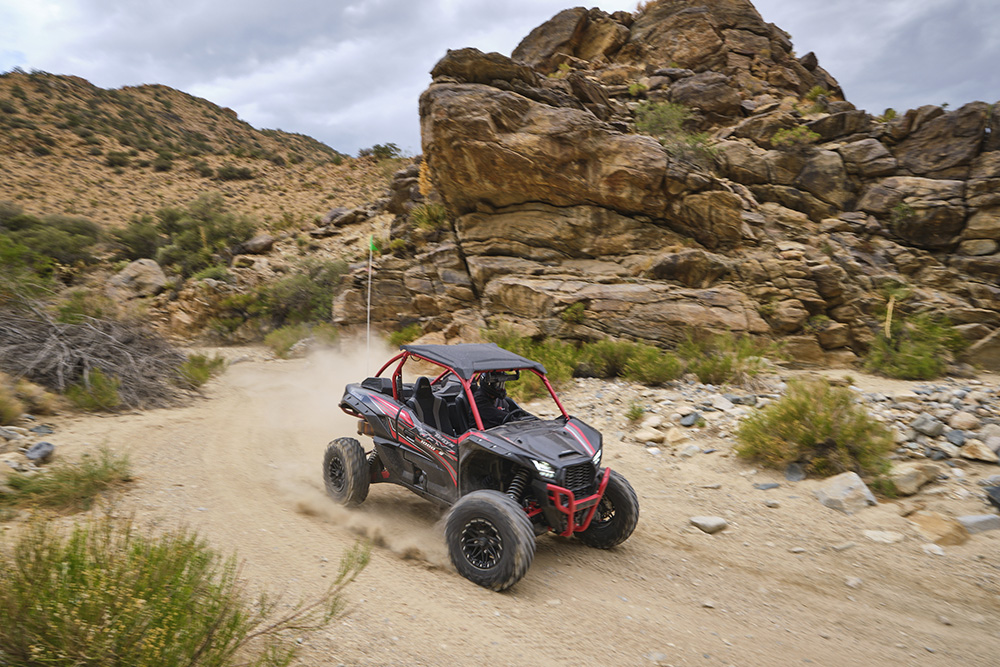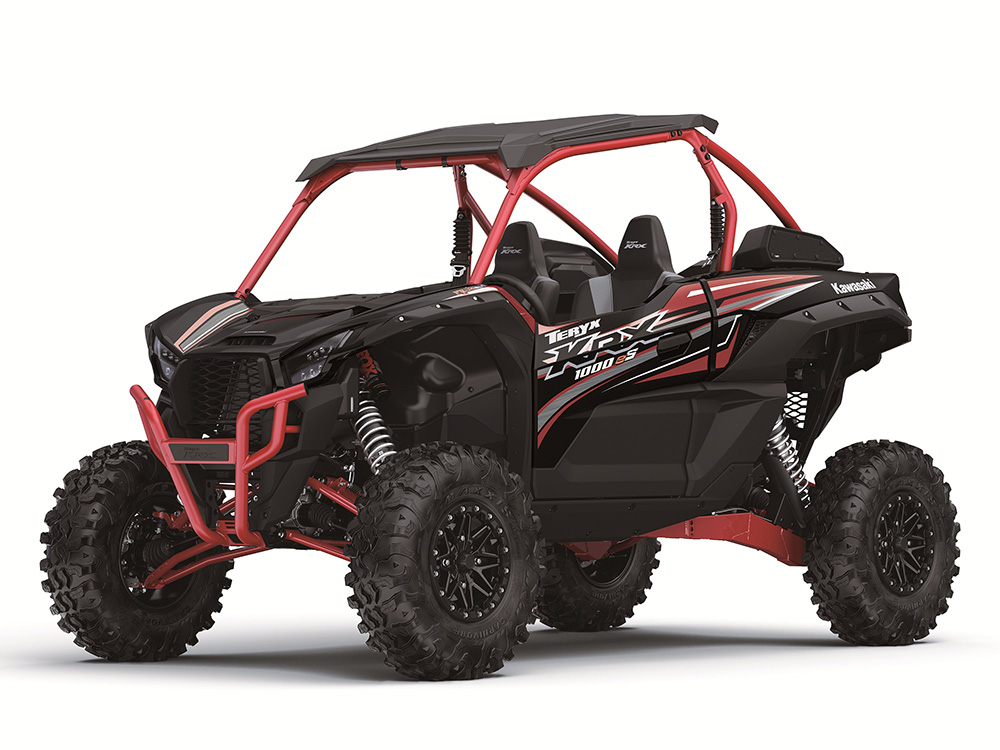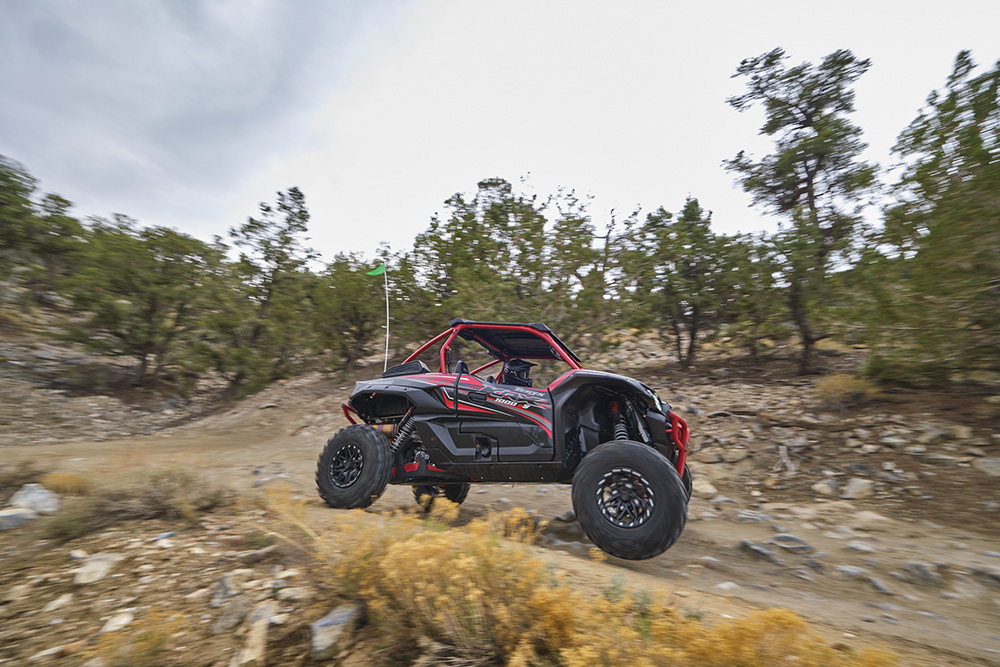Kawasaki’s Live-Valve equipped KRX is a steamroller! Here is our 2021 Kawasaki KRX 1000 eS Review.
ALSO, SEE: 2024 Kawasaki Ridge Review
2021 KAWASAKI KRX 1000 eS Review
Words: UTV Off-Road Staff // Photos: Doug Henry / Kawasaki
Kawasaki’s KRX 1000 has been a raving success since its recent launch, and we have enjoyed quite a bit of seat time in the various versions of the KRX Kawasaki now offers. Recently, we got a couple of chances to spend some time in their new KRX eS, which is fitted with electronic suspension.
KECS, or Kawasaki Electronic Control Suspension, is a moniker that adorns this black and red KRX in a few places. This is the acronym that stands for the system that Kawasaki and Fox Racing Shox worked hand in hand to apply to the KRX. Using Fox’s Live Valve technology and a host of Kawasaki designed and tuned sensor systems, the KRX eS delivers an intelligently-valved ride on top of already-stellar Fox Podium Internal Bypass shocks.
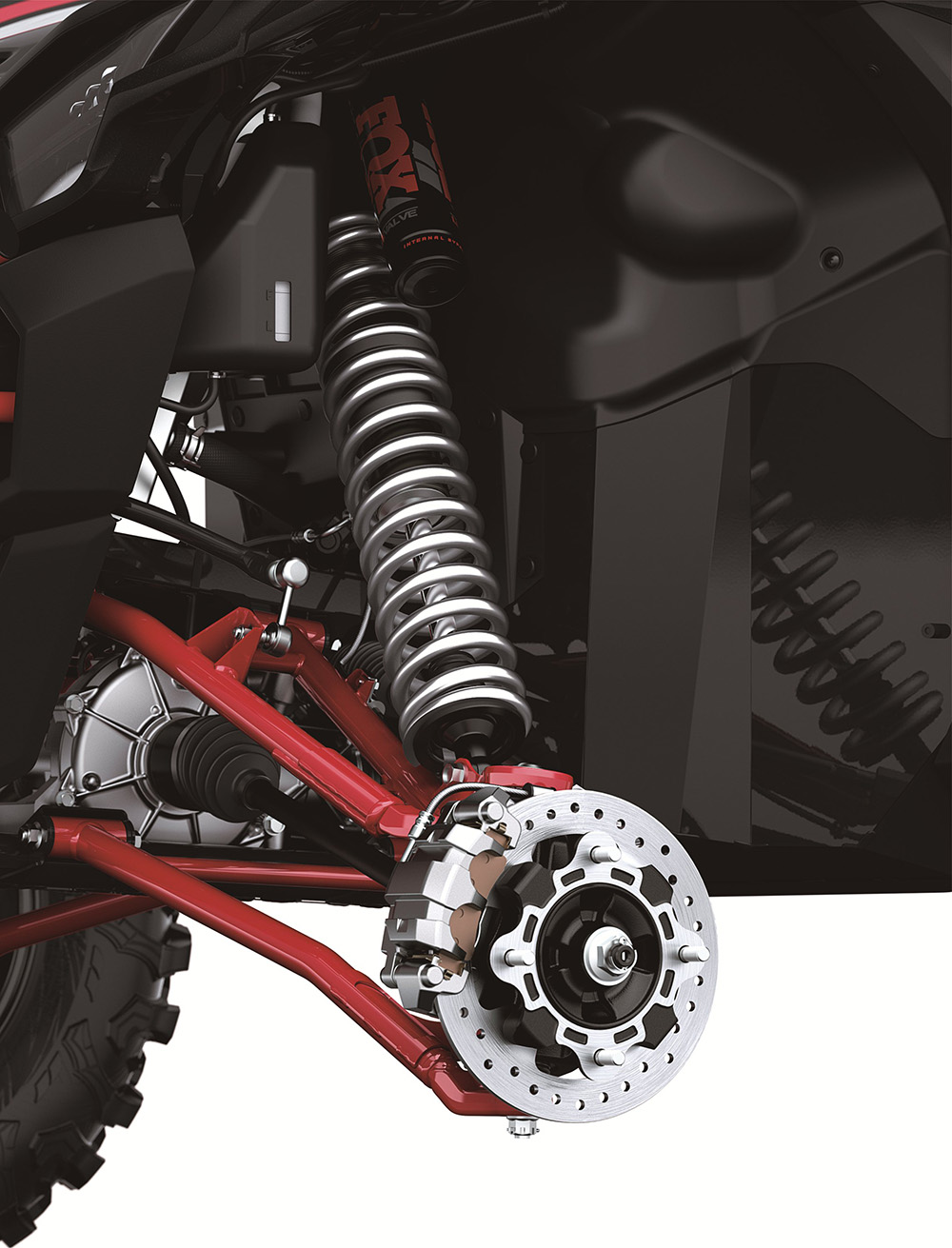
Internal Bypass technology works in conjunction with the KECS system to deliver a plush ride in any of the three adjustable firmness modes. It works to bleed off valving intensity during parts of the stroke that are furthest away from bottomed out, so it is softer at ride height than it is at full bottom. The result is a car that has three distinct changes in personality when you flick the suspension switch. In Soft mode, the car’s body movements are more pronounced, and the ride is very squishy. In Normal mode, the shocks are in a trail setting, perfect for railing around all day with your friends. Firm takes it up a notch for when you want to erase body roll and keep the car up high in the travel. It works great for low-speed rock sections and high-speed jumps and bumps.
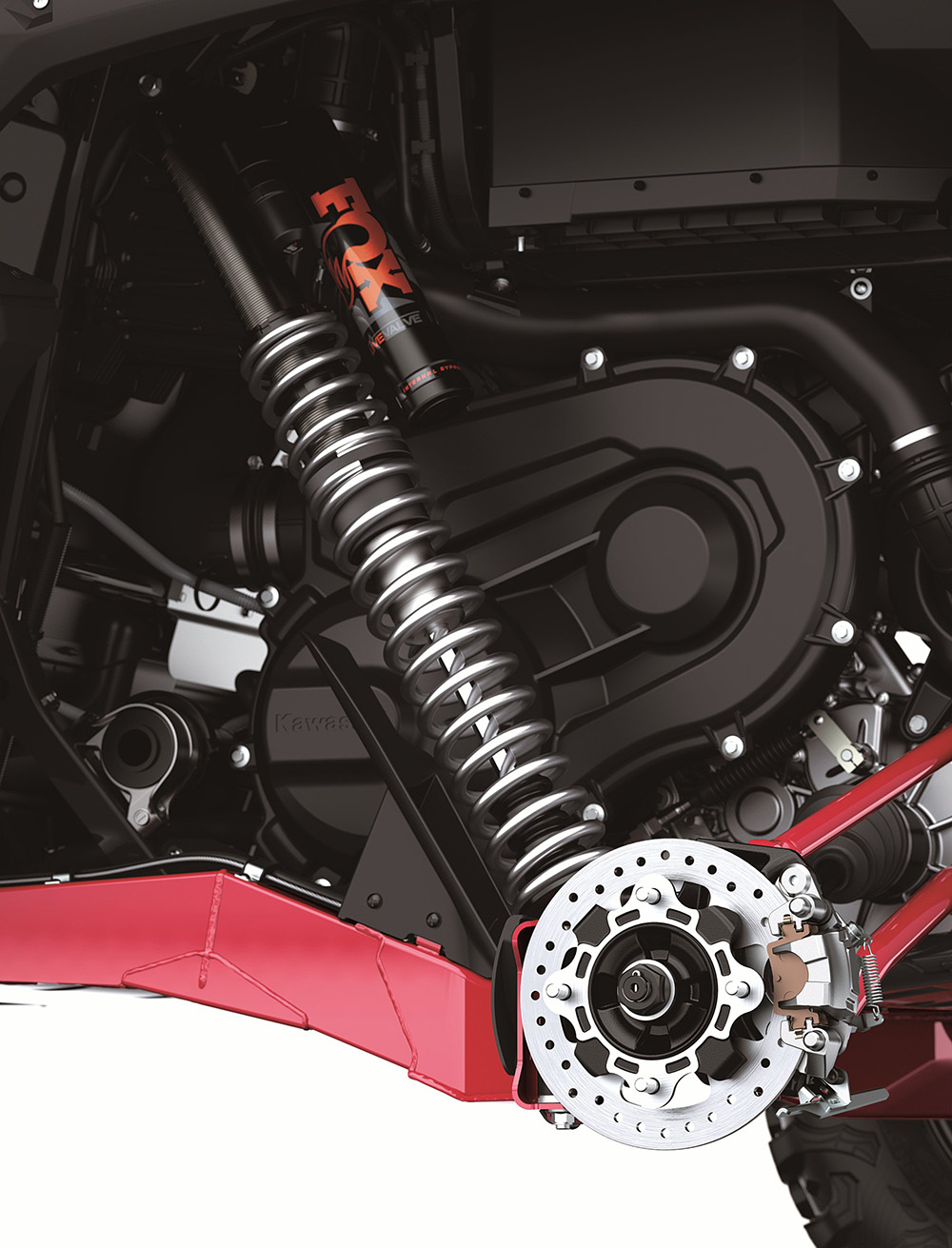
In addition to the trick suspension, or rather to compliment it, Kawasaki fitted the KRX eS with a 7-inch TFT LCD display in lieu of traditional gauges. It offers far more information in a much easier to read package, as well as multiple themes and pages to play around with. We loved the suspension readout screen, as the stiffness changes are shown in real-time. It is controlled by two dash-mounted rocker switches that are easy to reach from the driver’s seat, positioned just in front of the shifter. The KRX has ample room for mounting aftermarket accessories like radio communications or stereos, and also features a small storage compartment at the top of the dash and a large glovebox.
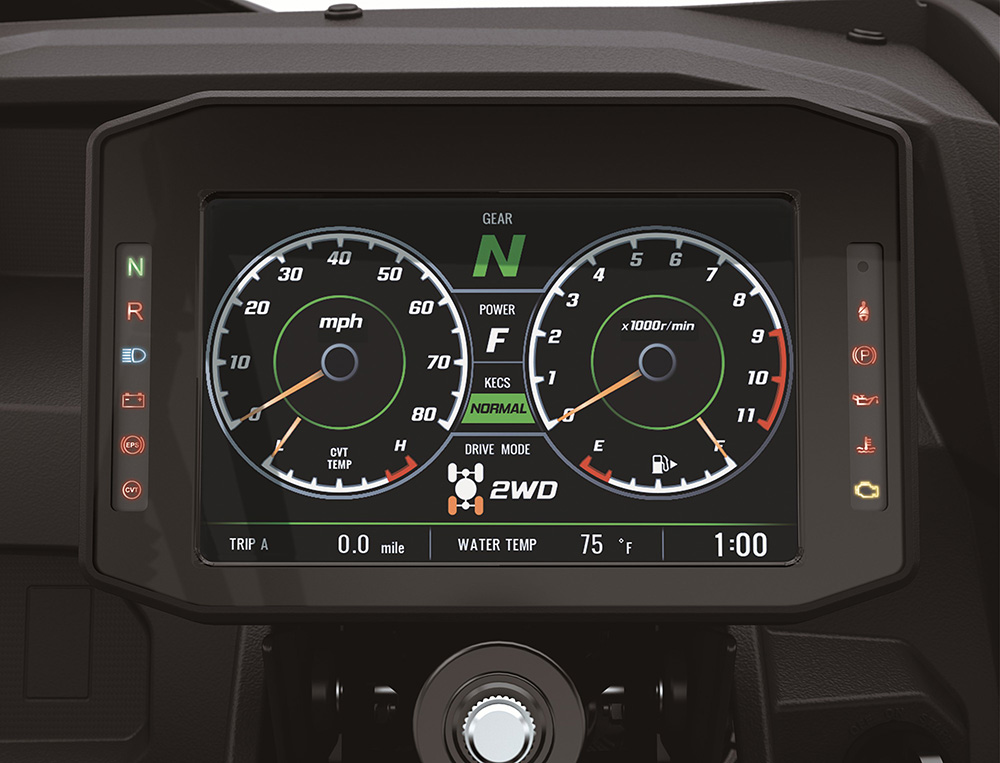
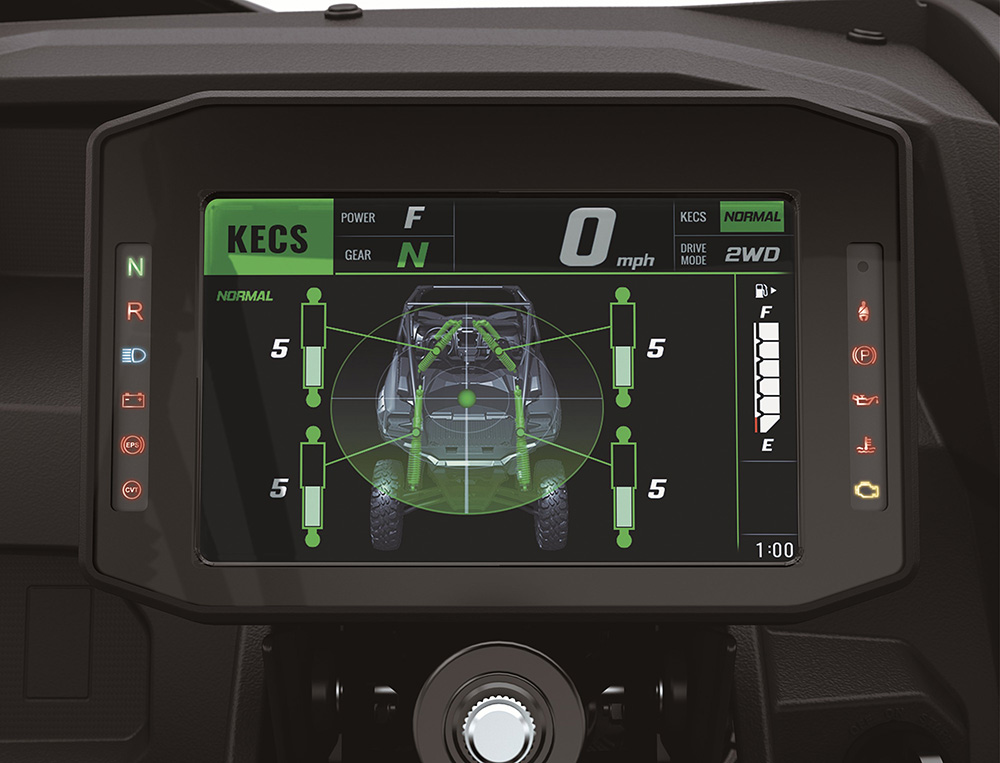
See all KRX eS Best Features Here.
The KRX eS uses massive dual A-arms up front to achieve 18.6 inches of wheel travel. When coupled with the very well-tuned Fox / KECS shock system, it allows the KRX to iron out just about anything you throw in front of it. 21.1 inches of rear suspension travel is controlled by a set of massive trailing arms and radius rods, similar to what you would find on a Polaris RZR Turbo S. This KRX competes directly against that Turbo S in the suspension category, and even in pricing. The Turbo S has a card up its sleeve that the KRX does not, however: turbocharged horsepower.
The KRX’s parallel-twin, dual overhead cam twin cylinder engine is stout, but the KRX is also fairly heavy, hitting the scales at just shy of a ton. We applaud Kawasaki for building the KRX in the fashion that it did, as the frame and suspension components are incredibly stout and well-engineered. The weight penalty the KRX takes over some of its competition may end up providing a much longer service life. Since the KRX is still so new, only time will tell.
The engine makes a little over 100 horsepower, so the KRX is not slow. Most of the KRX units we have driven top out around 68 mph, but they lack punch acceleration when you are north of 20 mph on the trail. There are multiple companies offering hop-up kits that help squeeze more juice out of the KRX’s engine, but we are hoping to see a higher-horsepower variant come out of the Kawasaki factory sometime soon. This chassis begs for higher horsepower, and it is one of the best-suspended cars you can buy right now!
The KRX has a few shortfalls, but luckily none of them are anywhere near ownership-threatening. The first is that these trick shocks are noisy, especially in the Soft suspension setting. The noise is nothing more than the spring dividers hitting the crossover rings, which they are designed to do. It is a distracting sound at some times, but it is also one that can be remedied with some help from the aftermarket. The second gripe we had with the KRX was the cutout in the center console cup holders. During hard driving, our knees made contact with these corners repeatedly, causing some discomfort. There are pad options available from the aftermarket that completely eliminate this problem. The third, and perhaps most comical, is that the center console cupholders become extremely hot during long use. We have seen some videos of this popping soda cans and otherwise rendering things un-drinkable: there are a few options to fix this, most of which involve insulating the under side of the center console. Luckily, it is an easy fix!

The KRX’s interior panel fitment is very good, and the doors are high quality on both sides. There are even internal and external door latches, something not often seen on a UTV. The full-coverage doors open widely enough to make ingress and egress easy, and the seating position is fairly upright and comfortable for long days on the trail. Speaking of long days on the trail, the KRX features a 10.6-gallon fuel tank, long enough for us to log over 150 miles on a single fill-up.
Kawasaki designed all KRX models to run a 31-inch tire from the factory, so the suspension and steering are up to the task. Steering effort feels light and consistent, despite the massive traction the 31-inch Maxxis Carnivore tires produce. The KRX produces very strong mechanical grip, which allows you to carry a ton of momentum in corners. Coupled with its incredibly capable suspension, this means you can really hammer the KRX through rough sections of trail without backing off. It is incredibly composed in the rough, and the chassis always seeks level even when bottoming the rear end (if you can get it to).
With a ton of hard miles under our belt with the KRX chassis this year, we can tell you that the eS model is a definite upgrade over the base and Trail/SE models. Even without the Live Valve and KECS, the shocks themselves would be a massive upgrade over those on the standard cars, as they are fitted with internal bypass technology and a host of upgraded materials to make them more durable long-term. The adjustability and ride comfort afforded by the KECS system is something we very much enjoyed. The 7-inch display, accessory bumper and roof, and Metallic Onyx Black paint with red accents is enough to justify the rest of the price tag. The KRX eS’ suspension performance is at the top of the food chain when it comes to the naturally aspirated sport category, living up to the Teryx name.
ALSO, SEE: 2024 Kawasaki Ridge Review
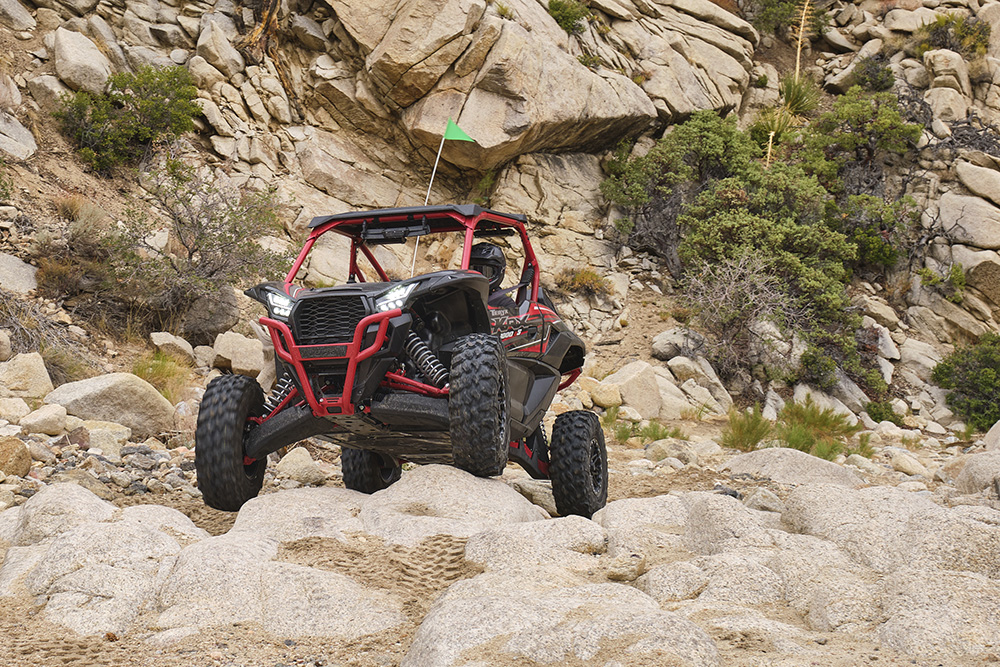
2021 Kawasaki KRX 1000 eS Review
SPECIFICATIONS:
Engine Type: Liquid-Cooled, 4-Stroke Parallel Twin, DOHC, 4-Valves per Cylinder
Displacement: 999 cc
Bore & Stroke: 92.0 x 75.1 mm
Maximum Torque: 76.7 lb-ft @ 7,000 rpm
Compression Ratio: 11:5:1
Fuel System: DFI® with Two 50mm ETV Throttle Bodies
Front Tire Type Size: Maxxis Carnivore 31 x 10.00R15 8PR, Bead-lock Wheels
Rear Tire Type/Size: Maxxis Carnivore 31 x 10.00R15 8PR, Bead-lock Wheels
Wheelbase: 98.8 in.
Front Brake Type: 258mm Hydraulic Discs, 32mm Twin-piston Calipers
Rear Brake Type: 258mm Hydraulic Discs, 38mm Single-piston Calipers
Front Suspension Type: Double wishbone, FOX 2.5 Live Valve Internal Bypass shocks with piggyback reservoir, KECS-controlled compression damping, and manually-adjustable preload
Rear Suspension Type: 4-link trailing-arm, FOX 2.5 Live Valve Internal Bypass shocks with piggyback reservoir, KECS-controlled compression damping, and manually-adjustable preload
Front Wheel Travel: 18.6 in.
Rear Wheel Travel: 21.1 in.
Ground Clearance: 14.0(Std. Preload)/14.4 (Max Preload) in.
Fuel Tank Capacity: 10.6 gal.
Track Front/Rear: 59.3 in. / 59.4 in.
Length x Width x Height: 132.1 x 68.1 x 77.0 in. (AMFNN)
Bed Length x Width x Height: 14.6 x 33.1 x 9.1 in.
Bed Load Capacity: 351 lb.
Curb Weight: 1944.8 lb.
Warranty: 6 months or Kawasaki Protection Plus™ 12, 24 or 36 months

